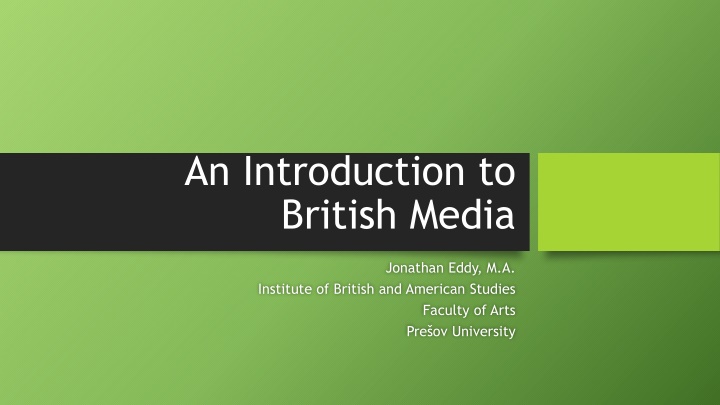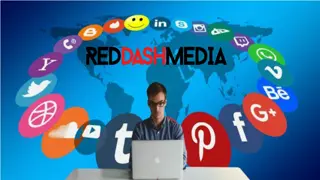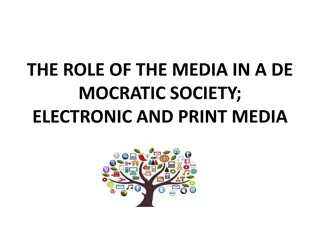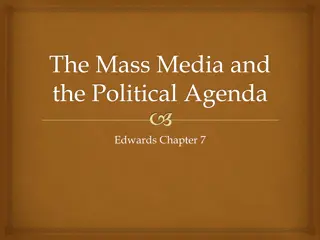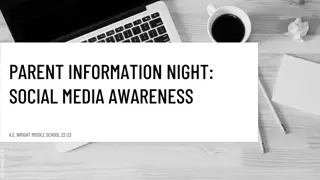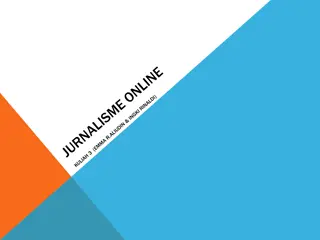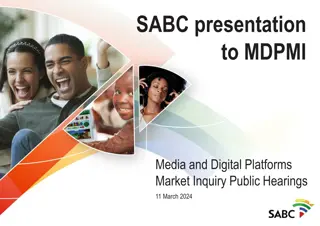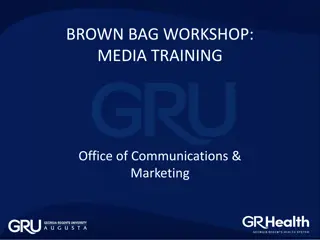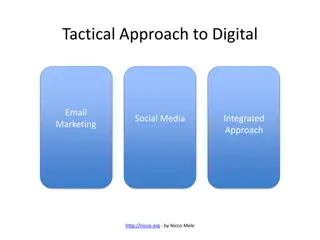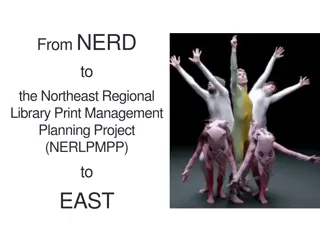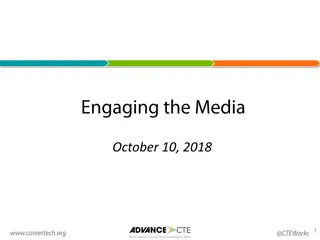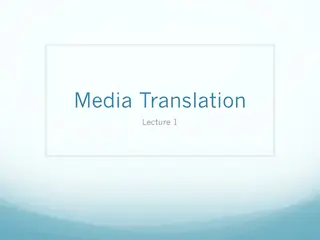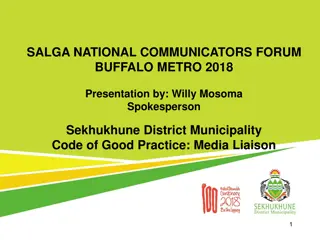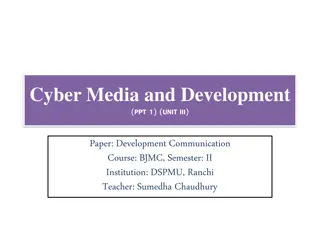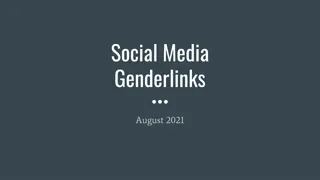An Introduction to British Media: Overview of Print and Digital Platforms
This content provides an insightful overview of the British media landscape, focusing on newspapers, television, radio, and social media. It discusses the distinctions between tabloids and broadsheets, highlighting the influence of British media on social and political views. Key characteristics of popular British newspapers are outlined, shedding light on their editorial stances and reader demographics.
Download Presentation

Please find below an Image/Link to download the presentation.
The content on the website is provided AS IS for your information and personal use only. It may not be sold, licensed, or shared on other websites without obtaining consent from the author.If you encounter any issues during the download, it is possible that the publisher has removed the file from their server.
You are allowed to download the files provided on this website for personal or commercial use, subject to the condition that they are used lawfully. All files are the property of their respective owners.
The content on the website is provided AS IS for your information and personal use only. It may not be sold, licensed, or shared on other websites without obtaining consent from the author.
E N D
Presentation Transcript
An Introduction to British Media Jonathan Eddy, M.A. Institute of British and American Studies Faculty of Arts Pre ov University
Contents Print Media Local Press Television Social Media Radio Revision Materials Glossary of terms
Print Media in the U.K. 11 daily and 9 Sunday newspapers in the UK (2016) divided into popular red top/tabloids; midmarket; and quality products Tabloids offer a condensed form of journalism, focusing more on the emotional rather than the factual impact of journalism. They can be divided into Red tops ; named after the red banner at the top of the front page (e.g. The Sun, the Mirror) and conservative tabloids (The Mail, The Express)
Print Media in the U.K. Broadsheets offer the reader more detailed, fact based journalism and can be divided into left-leaning broadsheets (e.g. The Guardian) and conservative broadsheets (e.g. The Telegraph). The top selling tabloid (2017) is The Sun and the top selling broadsheet (2017) is The Telegraph. All dailies have a version which is printed on Sundays. However, some titles, like The Guardian, have a sister paper, in this case The Observer, which is only published on Sundays. The two largest publishing groups in the U.K. are News International, and Daily Mail and General Trust. Together, they control 54% of the market share.
Characteristics of British newspapers Newspaper titles generally reflect and influence the social and political views of their readers. Generally speaking, tabloids prefer a more visual layout on their pages; typically a large photograph, large font, short headlines and a much less text based style of reporting, Broadsheets prefer longer headlines and a much more text dense approach Conservative tabloids : The Mail is generally anti-Europe and pro-Brexit, critical of left-leaning politicians and headlines often focus on the social problems Britain faces. The Express is similar to the Mail but takes more interest in the Royal family
Characteristics of British newspapers The Red Tops : Focus is on domestic news, sport, celebrity and scandal. The Sun, in particular is rather controversial. In 1982, during the Falklands War, it printed a full page photograph of the Argentine warship, the General Belgrano, sinking after being torpedoed by the Royal Navy with the one word headline Gotcha , meaning Got you , making fun of the event (the term gotcha journalism now means the lowest quality form of journalism), from 1970-2015, they ran a full page topless picture of a female model every day ( Page Three girls ) in order to attract more male, working class, readers.
Characteristics of British newspapers The broadsheets: The Times is Britain s oldest daily newspaper (1785) and is owned by the same company (News International) that owns The Sun but enjoys a much better reputation due to its age and the content and quality of its journalism. Abraham Lincoln calling it 'the most powerful thing in the world except, perhaps, the Mississippi river'. The Telegraph (1855) is Britain's best-selling quality paper with strong news and sports coverage. Politically right-wing (nickname: the Torygraph Conservative (Tory) Party) due to its support of the
Characteristics of British newspapers The Guardian is a liberal, quality daily. Nickname: the 'Grauniad' because of its reputation for literals Founded as the Manchester Guardian in 1821 and was the first daily outside London in 1855. Its sister paper, The Observer, is the world s oldest Sunday paper and is also a liberal, quality broadsheet.
Challenges facing British print media Between 2005 and 2017, total daily sales fell from 11.6m copies to 5.5m, a drop of 48%, an average fall of 4% a year; The biggest challenges are cost and competition from online news platforms; UK newspaper market is one of the leading markets in terms of digital innovation: The Telegraph was the first national newspaper to launch a website; the Daily Mail has one of the world's most popular websites; and 2016 saw the Independent and its Sunday sister title went online only.
Activity Look at today s front pages from British newspapers. Using the information in the lecture presentation, comment on which characteristic features you can see. https://www.bbc.com/news/blogs/the_papers
Local news media More than 80% of UK local newspapers by circulation are owned by just six companies. Local newspapers were so popular in pre-Internet days because of their importance for local advertising. Since 2005, 148 newspapers have launched and 379 have closed. The Internet has taken away a large amount of advertising money from local newspapers as well as being able to spread local news much faster. The elderly have been hardest hit by the decline in local newspaper as they are losing a connection to their community. More than anything they find themselves increasingly having to turn to unreliable word-of- mouth sources either in real life or on Facebook or WhatsApp groups to find out what is going on.
Television Television broadcasts in the UK began in 1936. Currently, the UK television market offers over 480 channels and is a mix of free to air, free to view, subscription and on-demand services. There are six main channel owners and, since 2012, all TV content in the UK has been offered on a digital platform. There are five main TV channels BBC 1, BBC 2, ITV, Channel 4 and Channel 5 - although all have other subsidiary channels available (e.g. ITV 2, E4, More 4, Five USA, BBC Four, BBC 6 music, etc.) as well as on demand or catch up (BBC i-player, 4OD, etc.) services.
Terrestrial television These five main channels can be divided into state television (the BBC) and commercial TV (ITV, Channel 4 and Channel 5). State television is funded by the taxpayer in the form of a television license, currently 154.50 (which also pays for BBC radio and the other BBC channels) as well as government grants and other state funding. There are no advertisements (other than channel idents and promotional clips for programmes) at all. The BBC has a remit a charter that it is obliged to fulfill and includes the responsibility to remain politically neutral, provide programming that caters for all members of the UK s population (this covers cultural, education, spiritual as well as minority content) and has the right to broadcast (for free) events of national importance , for example the Olympic games, the FIFA World Cup, the English F.A. Cup final, royal weddings, Proms concerts etc. The BBC also has a duty to make its own shows in order to promote and encourage British talent in media projects. These shows are often sold around the world (Top Gear, Fleabag, Doctor Who, Sherlock and The Office being the most well known and profitable examples in recent years).
Some interesting facts On 18thApril, 1930, the BBC s 20:45 news bulletin announced that there was no news to communicate at that time and the presenter played music instead. ITV (owner - ITV, plc), Channel 4 (Channel Four Television, Ltd.,) and Channel Five (Viacom) are commercial stations. ITV is the oldest, launching in 1955, and is a network of 15 regional stations operating under the ITV banner. Channel 4 first broadcast in 1982 and Five debuted in 1997. All three stations share some similarities all are privately owned and financed mainly through advertising before, during, and after programmes as well as sponsorship of shows. Commercial TV has no remit.
Syndication and franchising Commercial stations often buy a large part of the output in the form of syndication (the buying of the rights to television programmes and broadcasting them in their original form e.g. The Simpsons (Channel Four), NCIS (Channel Five) or franchising (the buying of the concept of a show and then reproducing the format for the target audience) e.g. X Factor, Britain s Got Talent (ITV), Big Brother (Channel Four, later Channel Five). Commercial television has traditionally had less interest in sporting events as they were often shown by the BBC; however, in recent years, all the three main commercial channels have included more sporting content in their schedules.
Satellite, cable and digital television Satellite (cable, digital) television can be categorized broadly into the following types free to air, free to view, subscription and special or single interest. UK satellite TV began when Rupert Murdoch launched Sky TV in the UK in 1990. The Simpsons was first shown in the UK on Sky One. Another early success for Sky was American wrestling and sport, especially the English Premiership football league has been one of the driving factors in buying a Sky subscription although Sky now faces a lot more competition from online broadcasters. Free to air channels are digital stations which come with set top box technology (Freeview, Freesat, etc.,) and are free to watch provided one has the technology installed; essentially, it is the version of traditional terrestrial TV which is carried digitally nowadays. Free to view channels can only be viewed alongside a subscription or a viewing card.
On-demand TV In recent years, a new sector has entered the television market on-demand and streaming services; the most famous being Netflix and Amazon Prime. Netflix began in the early 2000s as a DVD- lending library; however, as the online market grew and DVDs sales and rentals dropped, Netflix expanded its business model into on-demand TV.
On-demand TV The basic principles of on demand TV are: Customers pay a monthly subscription fee to access their shows (the shows are always available in a personal library, can be viewed offline with premium accounts but cannot be downloaded onto a user s hard drive); There are no schedules; once shows have been released, you can watch what you want, when you want until the shows are deleted from the channel s library. On-demand networks release entire seasons (or box sets) of shows so customers can watch entire seasons of shows rather than waiting for a week or two or three for a new episode on regular TV; On-demand TV is cross-platform users can watch wherever they are on whatever device they choose (TV set, mobile phone, tablet).
Types of Television Programmes Soap Opera Soap operas began as sponsored radio, and later TV, shows primarily aimed at housewives. The soap comes from the fact that the original sponsors were laundry detergent companies. There are a number of types of soap opera, which can be defined as follows: Family-based: Most, if not all, the central characters belong to one family, for example, the American soap Dallas revolved around the Ewing and Colby families. Location-based: The characters all live or work in the same place. Famous examples include both Eastenders (Walford, a fictional London borough) and Coronation Street Manchester) or the Australian Soap Neighbours which is set on Ramsey Street. The majority of job-based soaps seem to be set in hospitals (Doctors in the UK, for example) given that the potential for drama in hospitals is much higher than most other jobs. (Wetherby, a fictional part of
Types of Television Programmes Soap Opera Aspirational: These soaps are less real life in their plots and usually feature wealthy, powerful, glamourous characters whose lives provide escapism from the real world. The South American style telenovela or US soaps like The Young and the Restless are good examples of aspirational soaps. A feature of all soaps is a 12-week story arch where plotlines are developed over that time frame and, at any given time, one plot is starting, two more are in the middle and one is ending. The most well-known British soaps are: Coronation Street (fictional Manchester suburb), ITV, 1960- Eastenders (fictional London suburb,) BBC, 1985 Emmerdale (fictional Yorkshire village, originally Emmerdale Farm), ITV, 1972- Brookside (1982-2003, Liverpool), Channel Four s flagship show for many years
Types of Television Programmes - Sitcom British sit-coms tradition, or roots, can be found in several sources. Firstly, the variety style of entertainment which was popular in the days of Victorian music hall theatre comedy songs, skits or small sketches and characters dressing up in costume were features of music hall and those elements can still be seen in some British comedy. Another element is surrealism, British sitcoms and British comedy in general often has an element of the unreal or takes place within an exaggerated reality. The influence of surrealism can be traced back to the writings of Lewis Carroll or the nonsense poetry of Edward Lear as well as the psychedelic music of bands like Pink Floyd. A third common feature of British comedy is word play, often in the form of puns or innuendo (a common word or phrase given a suggestive, often sexual, second meaning). Due to the lexical complexity of some of this word play, British comedy is often said to be harder to understand than American humour. Like Czechoslovak comedy of the cabaret style, where outright or obvious criticism of politicians or the political system was dangerous, satire is another feature of British comedy; the use of irony or satire has a long heritage in British comedy, stretching back from music hall songs and sketches to political magazines like Punch or Private Eye and current events based shows like The Frost Report or That Was The Week That Was in the 1960s to more modern shows like Have I Got News For You or Mock The Week.
Types of Television Programmes - Sitcom The use of catchphrases is another common feature in British comedies; a line or a phrase which becomes attached to a particular character and he or she will invariably repeat this catchphrase at least once per episode. Several new wave comedy shows (The Fast Show, Little Britain, The Catherine Tate Show, Harry Enfield and Chums) abandoned all premise of traditional jokes in favour of a format containing many short sketches (typically 25-40 in a 30 minute episode) featuring a lot of regular characters, all of whom had a catchphrase and each sketch was set up so that the character could say their catchphrase rather than tell the punch-line of the joke. A final influence on British comedy is physical, slapstick comedy; humour of the man falls into hole type. A slapstick pioneer in the early days of Hollywood was the British born actor and director, Charlie Chaplin. A famous silent film from 1967 - The Plank - is one of the best known examples of British slapstick and, later and more famously, Mr. Bean successfully updated this format for modern audiences.
Examples of British Sitcoms https://www.youtube.com/watch?v=tjJc8xLYhak (Mrs. Brown s Boys) https://www.youtube.com/watch?v=5b-DsPazO9c (Office) https://www.youtube.com/watch?v=5XZCYE4k2wU (Peep Show) https://www.youtube.com/watch?v=vnciwwsvNcc (Monty Python) https://www.youtube.com/watch?v=7xnNhzgcWTk (Fawlty Towers) https://www.youtube.com/watch?v=63rcdLeXiU8 (Only Fools And Horses) https://www.youtube.com/watch?v=72BrqGNvaT0 (Alan Partridge) https://www.youtube.com/watch?v=HWc3WY3fuZU (IT Crowd) https://www.youtube.com/watch?v=q8T8p1x-R5g (Mighty Boosh) https://www.youtube.com/watch?v=LT-b1qXznKI (Fast Show) https://www.youtube.com/watch?v=zV1zK8zRCPo (Catherine Tate) https://www.youtube.com/watch?v=OSNY869xRdY (Little Britain)
Reality TV Reality TV is also a common feature of UK television and can be divided into three main genres: Fly on the wall Docu-soaps, (Airport, Cruise Ship, Driving School). As mentioned above, these shows follow people doing their jobs and often feature an off-screen narrator and talking head sections where they main protagonists are interviewed face to face. These shows remain very popular for both audiences, due to their soap -like nature and for programme makers, as they are very cheap to produce. In contrast to the American versions, British fly on the wall shows are less glamorous (Driving School vs. Ice Road Truckers, for example) and contain much less staged conflict. Several docu-soap stars have gone on to enjoy wider, albeit short lived, fame away from the original show. For example, Jeremy Spake from Airport and Jane MacDonald from Cruise Ship , as can been seen in these links: Jeremy Spake https://www.youtube.com/watch?v=Im4QVTC5Ks8) Jane MacDonald (https://www.youtube.com/watch?v=-Gpnw6hBkd4)
Reality TV Competition-based reality shows. This type of reality TV can be subdivided into house- or challenge-based shows like Big Brother or talent-based shows like X Factor. These shows have both celebrity and regular versions and usually feature a live vote to determine who leaves and who wins the show. The two most popular competition-based reality shows on British TV nowadays are Strictly Come Dancing (a re-boot of an older, ballroom-dancing-based show) and The Great British Bake Off (an elimination-based show where contestants bake cakes). Links: https://www.youtube.com/watch?v=0oLjkPM4mHQ (Strictly) https://www.youtube.com/watch?v=ps7zFhA3Kbg (GBBO) The final type of reality show is aspirational and usually follows the lives of famous or rich people doing normal things. Popular British examples are The Only Way Is Essex, Geordie Shore and Made in Chelsea. As is the case with most British shows, when compared to the US versions, in this case Keeping Up With The Kardashians, Real Housewives of Beverly Hills/Orange County, Jersey Shore, etc., are far less glamorous and flashy.
Drama Costume dramas (e.g. Pride and Prejudice,War and Peace, Poldark, Downton Abbey) are very popular both at home and abroad (especially with American audiences). In recent years, however, historical adaptations have come in for some criticism. Firstly, they have been criticised for dumbingdown , while simultaneously overly sexualising the original novels (the adaptations of War and Peace and Dr Zhivago were especially guilty of this and the television version of Poldark is as famous for the lead actor, Aidan Turner, appearing topless as it is for anything else) in an attempt to attract more viewers and, secondly, for diverting away from the source material. In the same way that HBO has developed George RR Martin sA Song of Ice and Fire books far past the point at which the novels (at present) stop and Hulu has progressed the storyline of The Handmaid s Tale way past Margaret Atwood s original text (there are three TV seasons at present with a fourth in the planning stage, while Atwood only released the sequel to the original novel in September, 2019), so too has the BBC extended Poldark past the length of the original novels. The most recent example of this trend is the BBC s dramatisation of Jane Austen s final, unfinished, novel Sanditon. The BBC s main historical adaption writer, Andrew Davies was given Austen s extant 11 chapters and asked to finish the story. However, he admitted that the source material was sufficient for one television episode so he had to write enough extra material to fill the show s eight episode run.
Drama Crime dramas. Crime is the UK s best selling genre of fiction, so it is only natural that there are many crime dramas on television but, if we are to compare UK and US crime dramas, the British versions are often more provincial and less sexy , often taking place in the corners of the UK or in made-up villages (e.g. Midsomer Murders, Taggart, Happy Valley) rather than big cities (CSI: Miami/Las Vegas/New York) and focus as much on the characters private lives as the crimes going on. British crime dramas often mix elements of comedy with the drama so they can be said to be crossover shows (Death in Paradise, Agatha Raisin, Murder in Successville). The Agatha Christie tradition of the reveal is still used (e.g. Death in Paradise, Midsomer Murders) where the detective (amateur or professional) assembles the main suspects and then tells them who committed the murder while they all sit patiently and listen before the killer is (reluctantly) arrested.
Drama Due to its increasing and sustained popularity on screen and in books, in recent years, British TV stations have tried to copy the format of Scandi-Noir style crime dramas (e.g. Bron (The Bridge), Forbrydelsen (The Killing), f r (Trapped), etc.) in an attempt to re-boot or modernise the genre. These shows typically feature a troubled, loner , central character with deep personal issues (addiction, family crises, mental health issues), multiple narratives coming together over the duration of the season, redherring plotlines which take the narrative into misleading areas, a high functioning sociopathic killer or villain, often operating in a high powered job with a model family (in contrast to the detective s own difficult personal life) and sinister interference from unseen higher powers in the background. The most successful examples being the BBC s semi-Welsh language Hinterland or Luther, ITV s Marcela, Liar or the cold case based series, Unforgotten.
Revision What are the characteristic features of tabloid and broadsheet newspapers? Give an example of the following newspapers: A red top A quality broadsheet A conservative tabloid A Sunday paper which is not published in the week What are the main causes of the decline in UK local print media? What are the differences between state and commercial television? Define syndicated and franchised television programmes In what ways is on-demand TV different from traditional television? Give some characteristic features of a sitcom, a soap opera and a crime drama
Social Media The growth in social media is linked to improvements in Internet and telephone technology (e.g., faster broadband and WiFi connectivity and coverage, the launch of 4G and 5G as well as smartphones and tablets). Friends Reunited (2000-2016) was a way of bringing former classmates and colleagues together and My Space (2004-). My Space was actually the world s leading social network between 2005-2008 and still had over 50 million regular monthly visitors as well as over 1 billion active or inactive accounts as recently as 2015. Facebook (2004-): one of the bigfour tech companies with Apple, Amazon and Google. With annual revenue of over 50 billion dollars (2018), it employs close to 40,000 people (2019). Facebook also owns WhatsApp and Instagram. Albeit one of the most successful companies of all time, Facebook has had scandals including alleged Russian hacking of accounts, allowing hate speech and terrorist videos to be posted and streamed and the Cambridge Analytica scandal of 2018 when Facebook allowed the company to mine the personal data of millions of accounts before the Brexit referendum.
Social Media Other types of social media include professional apps like LinkedIn (for business networking) and Pexels (a free version of Shutterstock) and Wilio (a social site offering professional services for hire) and Pinterest (lifestyle). 3.8 billion people use the internet; There are 2.89 billion active social media users; 68% of adults use Facebook; 35% of adults use Instagram; 24% of adults use Twitter; 25% of adults use LinkedIn; 29% of adults use Pinterest; 27% of adults use Snapchat.
Activity Source https://www.pewresearch.org/internet/fact-sheet/social-media/ Activity - Using the information on social media use, decide which social media site is most likely to be used by: An urban, university educated professional aged 18-49 looking for new job opportunities A teenage girl at high school and from a non-rural background A female aged under 50 earning at least $50,000/year The 18-49 demographic with at least some form of higher education and the retired; Equal amounts of men and women but not by the less well educated Seven times more teenage girls than female pensioners Facebook Twitter LinkedIn Instagram Pinterest Snapchat
Radio - History Radio broadcasts began in the UK in 1922 and in 1927 radio content was taken over by the BBC. The BBC s original mission statement was inform, educate and entertain and the corporation still tries to stick to this today. The first competitors to the BBC s monopoly were Radio Luxembourg who began broadcasting an English-language service, which could be picked up in the UK and Ireland, in 1933. In fact, the BBC s mainland monopoly lasted until 1973, when licences were finally granted to commercial stations. Perhaps the most famous offshore competitor to BBC radio was Radio Caroline a station which broadcast to the UK from 10 boats. Caroline was launched in 1964 and continued broadcasting until 1989. In 1967, an act was passed banning any British citizen from working on these pirate radio stations in an attempt to kill Caroline. In 1932, the BBC began to broadcast its EmpireService , which provided programming in English for overseas listeners. It is now known as the WorldService .
Radio Stations There are around 600 licensed radio stations in the country. The most prominent stations are the national networks operated by the BBC. BBC Radio 1 broadcasts mostly current pop music output on FM and digital radio, with live music throughout the year. BBC Radio 2 is the United Kingdom's most listened-to radio station and plays popular music from the last five decades as well as special interest programmes in the evening. BBC Radio 3 is a classical music station, broadcasting high-quality concerts and performances. BBC Radio 4 is a current affairs and speech station, with news, debate and radio drama. BBC Radio 5 Live broadcasts live news and sports commentary with phone-in debates and studio guests.
Radio Stations The introduction of digital radio technology led to the launch of several new BBC stations: BBC Radio 1Xtra broadcasts rap, RnB and drum'n'bass. BBC Radio 4 Extra broadcasts comedy, drama and shows which extend or supplement popular programmes on its sister station, Radio 4. BBC Radio 6 Music transmits mainly alternative music, with many live sessions. BBC Radio 5 Live Sports Extra is a companion to Five Live. BBC Asian Network is aimed at the large South Asian community in the United Kingdom.
Commercial Radio Stations Commercial stations began broadcasting in 1973. The oldest commercial stations are the London-based stations LBC and Capital Radio. Radio Clyde was the first commercial station outside London and started broadcasting on 31st December, 1973. Also available nationally are three national commercial channels, namely Absolute Radio, Classic FM and talkSPORT. A highly popular format on commercial radio is talkradio , which features no music and prefers live phone-in debates or on-air interviews with politicians, sportsmen, etc. The two leading talk stations are Talk Radio and LBC (Leading Britain s Conversation). These stations are often much more controversial than the BBC. One of LBC s regular presenters is Brexit Party leader, Nigel Farage and his show made the world news when President Donald Trump called Farage live on air during his show.
Commercial Radio Stations The top ten most listened to stations in the UK (as of 1st August, 2019): BBC Radio 2 (14.5m listeners every week) BBC Radio 4 (10.6m) BBC Radio 1 (9.6m) Heart (8.5m) (most popular non-BBC station) Capital (7.2m) Classic FM (5.6m) BBC Radio 5 live (5.2m) Smooth (5.1m) KISS (4.2m) Magic (3.3m)
Glossary of terms Banner the top of newspaper featuring its name Broadsheet a larger format style of newspaper Channel any television network or station Circulation the number of people who buy a newspaper Cross-platform available on any number of synched devices used by the same account Franchising the buying of a concept of a TV show and making a local market version Free-to-air - digital stations which come with set top box technology and are free to watch provided one has the technology installed Free-to-view TV channels which can only be viewed alongside a subscription or a viewing card Hacking illegal accessing of computers and online user accounts Headline the most important details of a story in the form of a short sentence (often syntactically incomplete)and placed above that story in a newspaper Ident - short for identifier ; an advertisement for a TV channel and its content shown on the same channel between programmes
Glossary of terms Literals spelling, grammar or factual mistakes caused by poor checking or a lack of time Market share the percentage owned or controlled by one product in a market Mining using the data contained in personal online accounts for marketing or other commercial purposes On-demand a type of television experience, usually online, where the viewer can watch what they want, when they want, how and where they want Red top British newspapers with a red banner (The Sun, the Mirror and the Star) Remit the obligation state TV channels have to produce certain types of programmes Subscription a fee, usually monthly or yearly that is paid in order to use a service, e.g. Netflix Syndication the buying of television programmes and then showing them dubbed into the local language Tabloid an A4 sized newspaper format
Thank you for your attention jonathan.eddy@unipo.sk
